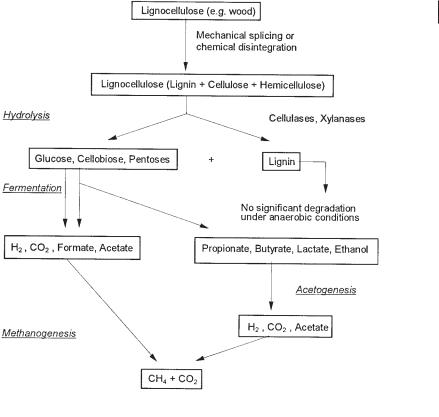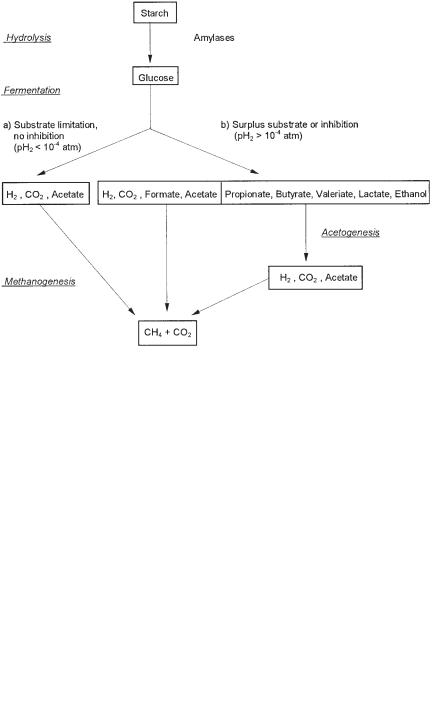
Environmental Biotechnology - Jordening and Winter
.pdf
1.2 Decomposition of Organic Carbon Compounds in Natural and Manmade Ecosystems 9
ic precipitation) or can be melted or emulsified (fat). Henze et al. (1997) reported hydrolysis constants kh for dissolved organic polymers of 3–20 d–1 under aerobic conditions and of 2–20 d–1 under anaerobic conditions, whereas for suspended solids the hydrolysis constants kh were 0.6 to 1.4 d–1 under aerobic conditions and 0.3 to 0.7 d–1 under anaerobic conditions. For a kinetic description of hydrolysis and fermentation, a substrate-limited first-order reaction was assumed by Buchauer (1997), who deduced that the temperature-dependent reaction rate for hydrolysis is a little lower than the reaction rate for fermentation of the hydrolysis products. The ratelimiting step is therefore hydrolysis of particles and not fermentation of solubilized material (Buchauer, 1997). Since hydrolysis is catalyzed not only by freely soluble exoenzymes, diluted in the bulk mass of liquid, but to a much higher extent by enzymes that are excreted in the neighborhood of bacterial colonies growing attached to the surface of the particles, the above description of complex fermentation processes is not always valid. Cellulases can be arranged in cellulosomes, which attach to the particles, which in turn serve as carriers until they themselves are solubilized. For this reason, Vavilin et al. (1997) included biomass in their description of the hydrolysis of cellulose, cattle manure, and sludge. Shin and Song (1995) determined the maximum rates of acidification and methanation for several substrates. For hydrolysis of particulate organic matter, the ratio of surface area to particle size is important. They found that for glucose, starch, carboxymethyl cellulose, casein, and food residues from a restaurant, hydrolysis proceeded faster than methanogenesis, whereas for newspaper and leaves hydrolysis was the rate-limiting step.
1.2.4
Hydrolysis of Cellulose by Aerobic and Anaerobic Microorganisms: Biological Aspects
Cellulose and lignin are the main structural compounds of plants. Both substances are the most abundant biopolymers on earth. Cellulose fibers are formed of linear chains of 100–1400 glucose units linked together by â-1,4-glycosidic bonds. Interand intramolecular hydrogen bonds and van der Waals interactions arrange the highly organized fibrous regions (crystalline region), which alternate with less organized amorphous regions in the cellulose fibers. The fibers are embedded in a matrix of hemicelluloses, pectin, or lignin. The hemicelluloses consist mainly of xylans or glucomannans, which have sidechains of acetyl, gluconuryl, or arabinofuranosyl units. To make cellulose fibers accessible to microorganisms, the hemicellulose, pectin, or lignin matrix must be degraded microbiologically or solubilized chemically. Cellulose degradation in the presence of oxygen in soil or in the absence of oxygen in the rumen of ruminants, in swamps, or in anaerobic digesters is the most important step in mineralization of decaying plant material. Cellulolytic organisms are found among aerobic soil fungi, e.g., within the genera Trichoderma and Phanaerochaete and in anaerobic rumen fungi, e.g. Neocallimastix and Piromyces, and among bacteria, e.g., within the genera Cellulomonas, Pseudomonas, and Thermomonospora (aerobic cellulose degraders) and Clostridium, Fibrobacter, Bacteroides, and Ruminococcus
(anaerobic cellulose degraders). For more details on cellulolytic bacteria and the mechanism of cellulose cleavage, please see Coughlan and Mayer (1991).

10 1 Bacterial Metabolism in Wastewater Treatment Systems
Glycosyl hydrolases are involved in cellulose and hemicellulose degradation by cleaving glycosidic bonds between different carbohydrates and between carbohydrates and noncarbohydrates. Endoand exocellulases – in some organisms organized in cellulosomes – must be excreted into the medium. Cellulases are complex biocatalysts and contain a catalytic site and a substrate-binding site. The presence of a noncatalytic substrate binding site permits tight attachment to the different forms of cellulose substrate and keeps the enzyme close to its cleaving sites. Substrate binding is reversible, which allows the enzyme to ‘hike’ along the fibers and obtain total solubilization. Many aerobic fungi and some bacteria excrete endoglucanases that hydrolyze the amorphous region of cellulose (degradation within the chain), whereas exoglucanases hydrolyze cellulose from the ends of the glucose chains. Cellobiose is cleaved off by cellobiohydrolases from the nonreducing ends in the amorphous region, and finally the crystalline region is also hydrolyzed.
Cleavage of cellobiose to glucose units by â-glucosidases is necessary to prevent cellobiose accumulation, which inhibits cellobiohydrolases (Be’guin and Aubert, 1994).
Anaerobic bacteria such as Clostridium thermocellum form a stable enzyme complex, the cellulosome, at the cell surface (Lamed and Bayer, 1988). Cellulosomes are active in degrading crystalline cellulose. The catalytic subunits of a cellulosome, endoglucanases and xylanases, cleave the cellulose fiber into fragments, which are simultaneously degraded further by â-glucosidases. Cellulosome-like proteins are found also in Ruminococcus sp. and Fibrobacter sp. cultures. The cell-bound enzymes are associated with the capsule or the outer membrane. Other specific adhesions or ligand formations with the cellulose can be facilitated by fimbrial connections, glycosylated epitopes of carbohydrate binding proteins, or the glycocalyx and carbohydrate binding modules (Krause et al., 2003). Some bacteria have not developed a mechanism to adhere to cellulose fibers, but excrete cellulases into the medium. Adsorption of bacteria onto cellulose fibers via cellulosomes offers the advantage of close contact with the substrate, which is hydrolyzed mainly to glucose, which is then taken up and metabolized. Small amounts of cellobiose must be present initially to induce cellulase expression. The contact of bacteria with the solid substrate surface keeps them close to cellobiose and thus keeps cellulase activities high. However, accumulation of hydrolysis products such as glucose repress cellulase activity.
In nature most cellulose is degraded aerobically. Only about 5%–10% is thought to be degraded anaerobically, which may be an underestimate. Since most ecosystems are rich in carbonaceous substances but deficient in nitrogen compounds, many cellulolytic bacteria can also fix dinitrogen. This is advantageous to them and to syntrophic or symbiotic organisms (Leschine, 1995). Other examples of mutual interactions between organisms of an ecosystem are interspecies hydrogen transfer between anaerobes (anaerobic food chain), transfer of growth factors (mycorhizzae, Kefir), and production of fermentable substrates for the partner organisms (bacterial interactions in the rumen).
Hydrolysis of biological structural components such as cellulose, lignin, and other structural or storage polymers (Table 1.2) is difficult. The limiting step of hydrol-

1.2 Decomposition of Organic Carbon Compounds in Natural and Manmade Ecosystems 11
ysis seems to be liberation of the cleavage products. In contrast to the slow hydrolysis of celluloses, mainly due to lignin encrustation of naturally occurring celluloses, starch can be easily hydrolyzed. The branching and helical structure of starch facilitates hydrolysis (Warren, 1996). Whereas cellulose forms fibers with a large surface covered with lignin, starch forms grains with an unfavorable surface-to-volume ratio for enzymatic cleavage. Thus, although amylases may be present in high concentrations, the hydrolysis rate is limited by the limited access of the enzymes to the substrate.
Whereas cellulose and starch are biodegradable, other carbohydrate-derived cellular compounds are not biodegradable and – after reaction with proteins – form humic acid-like residues by the Maillard reaction.
Table 1.2 Polysaccharides and derivatives occurring in nature.
Compound |
Bond |
Unit |
Occurrence |
|
|
|
|
Cellulose |
â-1,4- |
glucose |
plant cell wall |
Chitin |
â-1,4- |
N-acetyl glucosamine |
fungal cell and insect wall |
|
|
|
exoskeleton |
Murein |
â-1,4- |
N-acetyl-glucosamine |
bacterial cell wall |
|
|
N-acetyl-muramic acid |
|
Chitosan |
â-1,4- |
N-glucosamine, substituted |
fungal and insect materials |
|
|
with acetyl residues |
|
Mannans |
â-1,4- |
mannose |
plant material |
Xylans |
â-1,4- |
xylopyranose, substituted with acetyl- |
plant material |
|
|
arabinofuranoside residues |
|
Starch |
-1,4- |
glucose |
storage material in plant |
|
|
amylose (contains few -1,6-branches) |
|
|
|
amylopectin (contains many |
|
|
|
-1,6-branches) |
|
Glycogen |
-1,4- |
highly branched glucose with |
storage material in bacteria |
|
|
-1,6 bonds |
|
Dextran |
-1,2- |
glucose |
storage material in yeasts |
|
-1,3- |
glucose |
exopolymer of bacteria |
|
-1,4- |
glucose |
|
|
-1,6- |
glucose |
|
Laminarin |
â-1,3- |
glucose |
reserve material in algae |
|
|
|
|

121 Bacterial Metabolism in Wastewater Treatment Systems
1.2.5
Biomass Degradation in the Presence of Inorganic Electron Acceptors and by an Anaerobic Food Chain
In ecosystems in which molecular oxygen is available, plant and animal biomass is degraded to CO2 and H2O, catalyzed by either single species of aerobic microorganisms or the whole population of the ecosystem, in competition for the substrates. A single organism may be able to hydrolyze the polymers and oxidize the monomers to CO2 and H2O with oxygen. In ecosystems where molecular oxygen is deficient – such as swamps, wet soil, the rumen of animals, the digestive tract of humans, or in river and lake sediments – oxidation of dead biomass proceeds anoxically by reduction of electron acceptors such as nitrate and nitrite or anaerobically by reduction of sulfate, Fe3+, Mn4+, or CO2. The oxidation of the carbon source is either complete or incomplete with acetate excretion. In the absence of inorganic electron acceptors, oxidized metabolites such as pyruvate or acetate are reduced to lactate or ethanol or biotransformed to, e.g., n-butyrate or n-butanol. In permanently anaerobic ecosystems with seasonal overfeeding, periodic accumulation of such metabolites can occur, e.g., in autumn after the non-evergreen plants drop their leaves or decay completely. The biopolymers of the leaves or the plants themselves decompose by extracellular enzymatic hydrolysis. The monomers are fermented, and the fermentation products may be degraded further to biogas by acetogenic and methanogenic bacteria. Whereas single cultures of aerobes can catalyze the whole mineralization process to finally form CO2 and H2O, single cultures of strictly anaerobic bacteria are not capable of degrading biopolymers to CH4 and CO2. Under anaerobic conditions biopolymers must be degraded by a food chain via depolymerization (hydrolysis), fermentation (acidogenesis), oxidation of fatty acids (acetogenesis), and biogas formation (methanogenesis) as the last step (McInerney, 1988). In an initial exoen- zyme-catalyzed reaction the biopolymers are hydrolyzed to soluble mono-, di-, or oligomers. These are taken up by the bacteria and fermented to CO2, H2, formate, acetate, propionate, butyrate, lactate, etc. If fatty acid isomers are produced, they are mainly derived from degradation of amino acids after proteolysis. Fatty acids are further oxidized by acetogenic bacteria, before the cleavage products CO2, H2, and acetate can be taken up by methanogens and be converted to methane and CO2. Lactate is oxidized to pyruvate, which is decarboxylated to yield acetate, CO2, and H2. If ethanol is present, it is oxidized to acetate and hydrogen, and the hydrogen is used for CO2 reduction.
Table 1.3 summarizes the reactions that can be catalyzed by methanogens and that can contribute to methane emission in various ecosystems. In sewage digesters about two thirds of the methane is derived from acetate cleavage and one third from CO2 reduction with H2. If hexoses are the substrates and glycolysis is the main degradation pathway, then the 2 mol of pyruvate can be decarboxylated by pyruvate: ferredoxin oxidoreductase to yield 2 mol acetate and 2 mol CO2. The hydrogens of the 2 mol NADH2 from glycolysis and the 2 mol FdH2 from pyruvate decarboxylation are then released as molecular hydrogen at low H2 partial pressure (Eq. 3). Two

1.2 Decomposition of Organic Carbon Compounds in Natural and Manmade Ecosystems 13
Table 1.3 Reactions catalyzed by methanogens and standard changes in free energy.
Reaction |
|
|
|
|
|
|
ÄG°′ |
|
|
|
|
|
|
|
(kJ per mol of methane) |
Substrates (mol) |
|
Products (mol) |
|||||
|
|
||||||
|
|
|
|
|
|
||
Acetate |
→ |
CH4 + CO2 |
|
|
–31.0 |
||
4 H2 + CO2 |
→ |
CH4 + 2 H2O |
|
|
–135.6 |
||
4 HCOOH |
→ |
CH4 + 3 CO2 |
+ 2 H2O |
–130.1 |
|||
4 CO + 2 H2O |
→ |
CH4 |
+ 3 CO2 |
|
|
–211.0 |
|
4 Methanol |
→ |
3 CH4 + CO2 |
+ 2 H2O |
–104.9 |
|||
Methanol + H2 |
→ |
CH4 |
+ H2O |
|
|
–112.5 |
|
2 Ethanola + CO2 |
→ |
CH4 |
+ 2 acetate |
–116.3 |
|||
4 2-Propanolb + CO2 |
→ |
CH4 |
+ 4 acetone + 2 H2O |
–36.5 |
|||
4 Methylamine + 2 H2O |
→ |
3 CH4 |
+ CO2 |
+ 4 NH3 |
–75.0 |
||
2 Dimethylamine + 2 H2O |
→ |
3 CH4 |
+ CO2 |
+ 2 NH3 |
–73.2 |
||
4 Trimethylamine + 6 H2O |
→ |
9 CH4 |
+ 3 CO2 + 4 NH3 |
–74.3 |
|||
2 Dimethylsulfide + 2 H2O |
→ |
3 CH4 |
+ CO2 |
+ 2 H2S |
–73.8 |
||
aOther primary alcohols that are used as hydrogen donors for CO2 reduction are 1-propanol and 1-butanol (in a few species).
bOther secondary alcohols used as hydrogen donors for CO2 reduction are 2-butanol, 1,3-butanediol, cyclopentanol, and cyclohexanol (in a few species).
Compiled from Whitman et al. (1992) and Winter (1984).
moles of CH4 are then formed from acetate and 1 mol of CH4 by CO2 reduction (reactions 1 and 2 of Table 1.3).
1 mol glucose → 2 mol acetate + 2 mol CO2 + 4 mol H2 (at low pH2) |
(3) |
In complex ecosystems formate is formed if high concentrations of hydrogen accumulate. Syntrophic interactions are usually associated with interspecies hydrogen transfer, but evidence for interspecies formate transfer was also reported (Thiele et al., 1988). The feasibility of the electron carrier depends on its solubility, which is much less for hydrogen than for formate, and on its diffusion coefficient in water, which favors hydrogen 30 times over formate. The efficiency of the appropriate electron transfer depends mainly on the distance between the producing and consuming bacteria. It can be expected, that formate transfer is favored when the distance between communicating bacteria is high and hydrogen transfer when the distance is small (de Bok et al., 2004). Interspecies formate transfer is thought to play a major role in degradation of syntrophic butyrate (Boone et al., 1989) and propionate (Stams, 1994; Schink, 1997). However, at an increased H2 partial pressure formate is also produced by methanogens, either in pure cultures or in a sewage sludge population (Bleicher and Winter, 1994), and this may also contribute to increasing formate concentrations. Other substrates for methanogenic bacteria (Table 1.3), such as methanol (derived, e.g., from methoxy groups of lignin monomers) or methyl-

14 1 Bacterial Metabolism in Wastewater Treatment Systems
amines and dimethylsulfide (e.g., from methylsulfonopropionate in algae; Fritsche, 1998) are relevant only in ecosystems where these substances are produced during microbial decay. A few methanogens can also use reduced products such as primary, secondary, and cyclic alcohols as a source of electrons for CO2 reduction (Widdel, 1986; Zellner and Winter, 1987a; Bleicher et al., 1989; Zellner et al., 1989).
1.2.6
Roles of Molecular Hydrogen and Acetate During Anaerobic Biopolymer Degradation
Molecular hydrogen is produced during different stages of anaerobic degradation. In the fermentative stage, organisms such as Clostridium sp. and Eubacterium sp. produce fatty acids, CO2, and hydrogen from carbohydrates. In the acetogenic stage, acetogens such as Syntrophobacter wolinii and Syntrophomonas wolfei produce acetate, CO2, and hydrogen or acetate and hydrogen by anaerobic oxidation of propionate and n-butyrate (McInerney, 1988). Fermentative bacteria release molecular hydrogen even at a high H2 partial pressure and simultaneously excrete reduced products (e.g., clostridia, Ruminococcus, Eubacterium sp.). However, the release of molecular hydrogen during acetogenesis of fatty acids or of other reduced metabolites may occur only when hydrogen does not accumulate, for thermodynamic reasons. Molecular hydrogen is consumed by methanogens (Table 1.4, reaction 1) or, alternatively, by sulfate reducers (Table 1.4, reaction 2) via interspecies hydrogen transfer. In the rumen and in sewage sludge digesters, the hydrogen concentration can be decreased by acetate formation from CO2 and H2 (Table 1.4, reaction 3) by bacteria such as Acetobacterium woodii and Clostridium thermoaceticum. Some additional reactions consuming hydrogen to decrease its concentration are also listed in Table 1.4 (reactions 4–6).
To maintain a low H2 partial pressure, a syntrophism of acetogenic, hydrogenproducing and methanogenic, hydrogen-utilizing bacteria is essential (Ianotti et al., 1973). Complete anaerobic degradation of fatty acids with hydrogen formation by obligate proton-reducing acetogenic bacteria is possible only at H2 partial pressures <10–4 atm (n-butyrate) or 10–5 atm (propionate), which cannot be maintained by
Table 1.4 Hydrogen-consuming reactions in anaerobic ecosystems (Schink, 1997).
Substrates (mol) |
|
Products (mol) |
ÄG°′ |
||
|
|
|
|
|
(kJ per mol) |
|
|
|
|
|
|
(1) |
4 H2 |
+ CO2 |
→ CH4 + 2 H2O |
–131.0 |
|
(2) |
4 H2 |
+ SO42– |
→ S2– + 4 H2O |
–151.0 |
|
(3) |
4 H2 |
+ 2 CO2 |
→ CH3COO – + H+ + 2 H2O |
– 0.9 |
|
(4) |
H2 + S0 |
→ |
H2S |
– 0.9 |
|
(5) |
H2C(NH3+)COO– + H2 |
→ CH3COO – + NH4+ |
0.0 |
||
(6) |
COOH– CH–CH– COOH + H2 |
→ |
COOH– CH2– CH2– COOH |
0.0 |
|
|
|
|
|
|
|

1.2 Decomposition of Organic Carbon Compounds in Natural and Manmade Ecosystems 15
methanogens or sulfate reducers. However, by reversed electron transport electrons can be shifted to a lower redox potential suitable for proton reduction (Schink, 1997). If hydrogen accumulates beyond this threshold concentration, the anaerobic oxidation of fatty acids becomes endergonic and does not proceed (for details, see Chapter 8, this volume). Whereas hydrogen prevents â oxidation of fatty acids by acetogens even at very low H2 partial pressure, much higher concentrations of acetate (in the millimolar range) are required for the same effect.
The fermentative metabolism of acidogenic bacteria is exergonic even at H2 partial pressures >10–4 atm. Whereas acetogenic bacteria apparently depend mainly on ATP generation by chemiosmotic phosphorylation, fermentative bacteria produce most of their ATP by substrate chain phosphorylation. This may be why fermentative bacteria do not depend on a syntrophic interaction with electron-consuming bacteria, such as methanogens or sulfate reducers.
In addition to the possibility of anaerobic oxidation of organic compounds via synthrophic interactions between acetogenic bacteria and acetoclastic + hydrogenotrophic methanogens (see also Section 1.2.5), other synthrophic associations between acetate-oxidizing bacteria and H2/CO2-utilizing methanogens under thermophilic (Lee and Zinder 1988) and mesophilic (Schnuerer et al. 1996) growth conditions have been observed. Thermodynamic analysis of mesophilic synthrophic acetate oxidation revealed a hydrogen partial pressure of < 0.1–2.6 Pa, which is in the range found in methanogenic ecosystems (Dolfing, 2001). In thermophilic methanogenic reactors, acetate is degraded either by synthrophic acetate oxidizers (dominant process at low acetate concentrations) and acetate-degrading methanogens (acetate concentration above the threshold concentration) or by acetate-utilizing methanogens of the genera Methanosaeta or Methanosarcina (Ahring, 2003). Synthrophic acetate oxidation and methane formation from the cleavage products may explain the lack of acetoclastic methanogens (Methanosarcina sp. or Methanosaeta sp.) in anaerobic reactors.
1.2.7
Anaerobic Conversion of Biopolymers to Methane and CO2
The principle of the anaerobic metabolism of biopolymers was outlined by the pioneering work of Wolin (1976) and Bryant (1979). There is an essential requirement for syntrophic interaction between different metabolic groups for complete anaerobic degradation (Wolin, 1976, 1982). The most sensitive switch of the carbon flow of substrates to biogas is the H2 partial pressure. The substrate supply for biomethanation processes must be limited so that the most slowly growing group in the food chain, the obligate proton-reducing acetogens, can still excrete hydrogen at a maximum rate, but at the same time hydrogen accumulation >10–5 atm is prevented by active methanogenesis or sulfate reduction (Bryant, 1979). Whereas hydrogen seemed to be the most sensitive regulator of anaerobic degradation, formate (Bleicher and Winter, 1994), acetate, or other fatty acids accumulated to much higher concentrations (McInerney, 1988) but did not repress anaerobic degradation. If hydro-

16 1 Bacterial Metabolism in Wastewater Treatment Systems
gen accumulated due to an oversupply or to inhibition of methanogens, anaerobic biodegradation was disturbed successively in different stages. Initially, in the acetogenic stage â oxidation of fatty acids and alcohols failed, leading to an accumulation of these acid metabolites. Later, the spectrum of metabolites of the fermentative flora changed toward more reduced products like ethanol, lactate, propionate, and n- butyrate, leading to an even higher concentration of volatile fatty acids and a further decrease in pH. At pH values below 6.5, methanogenic reactions were almost completely prevented. At this stage acidification with a rich spectrum of reduced products still proceeded.
1.2.7.1 Anaerobic Degradation of Carbohydrates in Wastewater
Carbohydrates are homoor heteropolymers of hexoses, pentoses, or sugar derivatives, which occur in soluble form or as particles, forming grains or fibers of various sizes. In some plants, starch forms grains up to 1 mm in diameter, which is 1000 times the diameter of bacteria. Starch metabolism by bacteria requires hydrolytic cleavage by amylases to form soluble monomers or dimers, since only soluble substrates can be taken up and metabolized.
The anaerobic degradation of biopolymers in general and of cellulose in particular can be divided into hydrolytic, fermentative, acetogenic, and methanogenic phases (Fig. 1.3). Hydrolysis and fermentation of the hydrolysis products can be catalyzed by the same trophic group of microorganisms. The distinction of the two phases is of more theoretical than practical relevance. Concerning reaction rates in a methane fermenter that is fed with a particulate substrate, the rate-limiting step is hydrolysis rather than the subsequent fermentation of the monomers, if acetogenesis and methanogenesis proceed faster. The hydrolysis rates of polymers can be very different. Hemicellulose and pectin are hydrolyzed ten times faster than lignin-encrusted cellulose (Buchholz et al., 1986, 1988). In the acidification reactor of a two-stage anaerobic process, hydrolysis of polymers to monomers is normally slower than fermentation of monomers to fatty acids and other fermentation products. For this reason, no sugar monomers can be detected during steady-state operation. In the methane reactor, â oxidation of fatty acids, especially of propionate or n-butyrate, is the ratelimiting step (Buchholz et al., 1986). Fatty acid degradation is the slowest reaction overall in a two-stage methane reactor fed with carbohydrate-containing wastewater from sugar production. Thus, the methane reactor has to be larger than the acidification reactor to permit longer hydraulic retention times.
The rate of cellulose degradation depends strongly on the state of the cellulose in the wastewater. If cellulose is lignin-encrusted, lignin prevents access of cellulases to the cellulose fibers. If cellulose is mainly in a crystalline form, cellulases can easily attach to it, and then hydrolysis can be a relatively fast process. At increasing loading in an anaerobic reactor fed with crystalline cellulose, acetogenesis became the rate-limiting process, leading to propionate and butyrate formation (Winter and Cooney, 1980). In decaying plant material, cellulose is very often lignin-encrusted. Due to the highly restricted access to these complexes by cellulases, hydrolysis of cellulose is the rate-limiting step in its degradation to methane and CO2.

1.2 Decomposition of Organic Carbon Compounds in Natural and Manmade Ecosystems 17
Anaerobic degradation of lignocellulose and cellulose to methane and CO2 (according to ATV, 1994).
Whether microorganisms are capable of degrading lignin under anaerobic conditions is still under discussion. In a natural environment without time limitation, lignin was reported to be degraded anaerobically (Colberg and Young, 1985; Colberg, 1988). However, since these results were based on long-term experiments performed in situ and anaerobiosis was not controlled, it remains doubtful, whether the small amount of lignin that disappeared was really degraded under strictly anaerobic conditions. The occurrence of coal and fossil oil suggests that lignin compounds are highly resistant to microbial attack.
During anaerobic degradation of starch, hydrolysis by amylases proceeds with high velocity if good contact between starch grains and amylases is maintained. Whereas in an anaerobic reactor at low loading, starch degradation can proceed in the absence of acetogenic bacteria, as indicated in Figure 1.4 (route a), at high loading, volatile fatty acids are formed and acetogens are essential for total degradation (Fig. 1.4, route b). Figure 1.4 illustrates how the rate-limiting acetogenic reactions may be avoided by adjusting the conditions so that hydrolysis and fermentation occur no faster than methanogenesis. The rationale behind this is that many fermen-

18 1 Bacterial Metabolism in Wastewater Treatment Systems
tative bacteria produce only acetate, formate, CO2, and hydrogen when H2-scaveng- ing methanogens or sulfate reducers are able to maintain a sufficiently low H2 partial pressure, but a wide spectrum of fermentation products, typical for the metabolism of the respective bacterial species in pure culture, is produced at higher H2 partial pressure (Winter, 1983, 1984). Methanogenesis in continuous syntrophic methanogenic cultures can be disturbed by spike concentrations of sugars or – at low concentrations of sugars – by the presence of inhibitory substances like NH3, H2S, antibiotics (Hammes et al., 1979; Hilpert et al., 1981), or xenobiotics. In consequence, the H2 partial pressure increases and volatile fatty acids are generated (Winter, 1984; Winter et al., 1989; Wildenauer and Winter, 1985; Zellner and Winter, 1987b). Once propionate or n-butyrate are produced, anaerobic degradation requires acetogens for â oxidation (Fig. 1.4, route b).
1.2.7.2 Anaerobic Degradation of Protein
Proteins are biological macromolecules, either soluble or solid (e.g., feathers, hair, nails). Outside the cell at an acid pH or in the presence of enzymes, soluble proteins precipitate, e.g., precipitation of casein by addition of rennet enzyme. The reaction sequences necessary for protein degradation in a methanogenic ecosystem are outlined in Figure 1.5. Hydrolysis of precipitated or soluble protein is catalyzed by sev-
Fig. 1.4 Anaerobic degradation of starch under lowand high-loading conditions.
